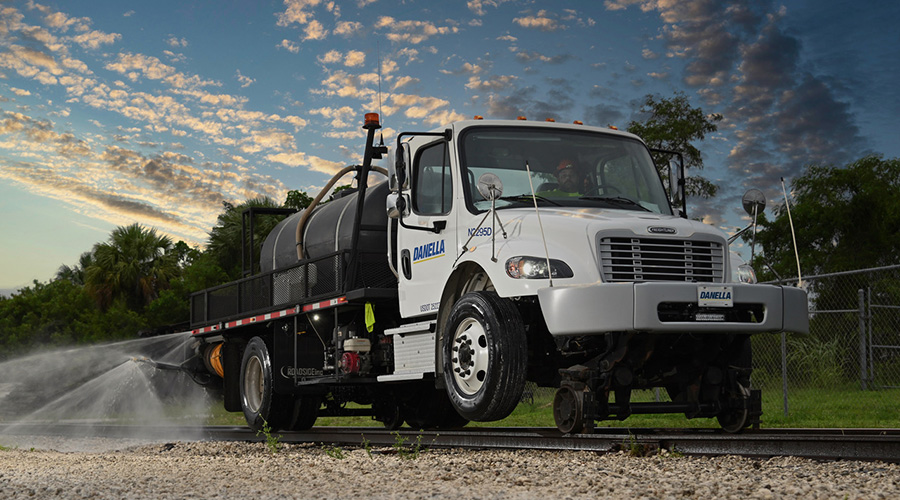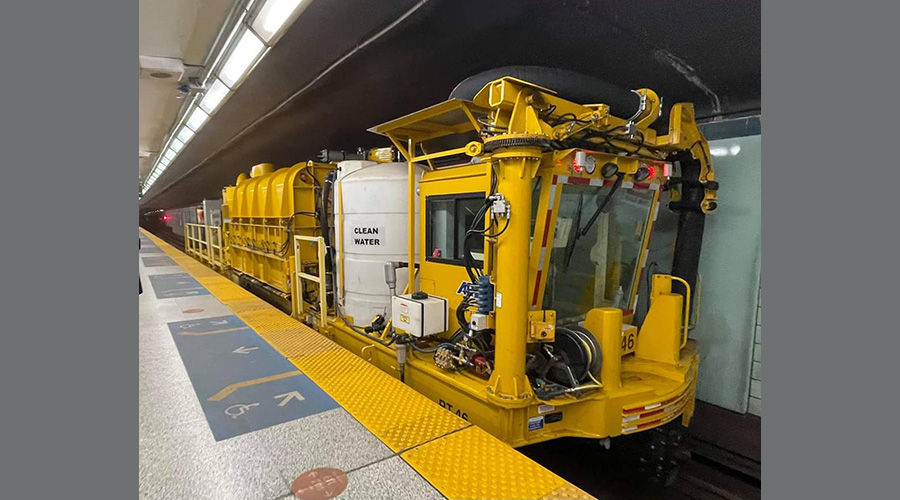Stay updated on news, articles and information for the rail industry
May 2015
Rail News: MOW
Vegetation management: a product and service update (part 2)
Progressive Railroading recently asked a sampling of contractors and equipment providers to discuss their services and technology offerings. Here's the second of a two-part series — part 1 appeared in our March 2015 issue.
Knox Kershaw Inc.
For controlling light brush, tree limbs and grass in areas most easily accessible by track, Knox Kershaw Inc. offers a Diamond Mowers Inc. brushcutter attachment for the KBR 925 Ballast Regulator and KSF 940 Snow Fighter.
“Customers who have added the brushcutter option to their Knox Kershaw machine have been pleased with versatility it offers on the job site, quickly converting from ballast regulator to vegetation manager based on the needs of the day,” the company says.
The brushcutters can be attached on both sides of the machine and operated simultaneously by two operators in the cab. The boom has up to a 28-foot reach from the centerline, and the actuator comes with 90 degree movement forward and 75 degrees rearward. It has a high-load bearing capacity and comes with a breakaway feature to prevent stress on the boom.
The booms are constructed of high-strength steel for “trouble-free” service, the company says. Boom and mower movements are controlled via main hydraulic control circuits utilizing Saur Danfoss PVG 32 valve banks and multi-function proportional joysticks. A variety of mower heads are available, including a 90-inch saw, 50-inch flail and 60-inch rotary styles. All heads can cut up to eight-inch diameter material. When idle, the brushcutter mowers rest securely on a rack/cradle mounted at the front of the machine.
The company offers five ballast regulator models, and each can be customized with a variety of options.
All Railroad Services Corp.
All Railroad Services Corp. (ARS) offers a range of railroad vegetation management services to Class I, short-line and passenger railroads in North America. The company — which has offices in Jacksonville and St. Augustine, Fla., and Philadelphia — provides environmentally safe weed and brush control services utilizing various types of mechanical and herbicide applications. Specifically, ARS provides:
- Off-track and hi-rail tree trimming for line-of-sight issues and encroaching brush, including line clearance for communication and overhead catenary systems.
- Tree, brush and weed clearing, including herbicide maintenance for clear line of sight and the growth of desirable grasses.
- Herbicide brush and weed control for railroad roadbed, branch lines, rail yards and off-track applications for storage areas. ARS also offers railroad pole line removal and disposal services; the company uses hi-rail and off-track equipment designed for the removal of out-of-service communication wire and poles.
Loftness Specialized Equipment Inc.
As part of its vegetation management product line, Loftness Specialized Equipment Inc. offers the Carbide Cutter G3 high-performance mulching head attachment for skid steers. The attachment incorporates “the latest cutting-tooth technologies and power drive systems, while maintaining the rugged reliability expected of Loftness equipment,” the company says.
The Carbide Cutter G3 is available with 51-, 61- and 71-inch cutting widths. All models are offered with a variety of carbide-tipped and heat-treated steel teeth. The engineered spiral tooth pattern on the rotor is designed to ensure continuous tooth contact with the material being cut.
The Carbide Cutter G3 features a two-stage cutting chamber with staggered counter teeth and a shear bar — a combination of features that results in small particle sizes while eliminating the jamming and wrapping issues associated with competitive products, the company says. An optional primary-stage shear bar also is available for ultra-fine mulching.
The mulching heads operate at 1,700 to 2,150 RPM and feature a four-groove banded belt drive with spring-loaded tensioner. They come standard with a fixed-displacement, piston-style motor that can be upgraded to a V-Drive system that includes a variable-displacement motor with load-sensing technology. Under light loads, the V-Drive system operates at maximum RPM; as the load increases, it automatically lowers the rotor RPM to maximize torque, according to the company.
Brandt Road Rail Corp.
The Brandt Rail Tool is a multipurpose platform that can be used in a comprehensive vegetation management program. The high-powered hydraulics allows users to equip and configure numerous attachments, including several brush cutters, according to the company.
There are many different types of brush cutters on the market, with rotary discs and drum style cutters being the most common, the company says. One requirement these brush cutters share is the need for significant hydraulic capacities. The Brandt Rail Tool ensures that the hydraulic requirements are “easily met” by employing a separate engine to power hydraulic functions, the company says.
The Brandt Rail Tool is a hi-rail excavator that can be used on rail or off; hi-railing to the worksite enables the Rail Tool to access areas standard road vehicles can’t, which in turn allows users to be productive in harder-to-reach, remote locations, the company says. The stability of the Brandt Rail Tool on rail, too, enables users to extend the boom and arm even farther.
“The main comment we hear about the Brandt Rail Tool’s brush cutting is how quickly it is able to complete the work,” the company says. “This efficiency allows the end user to move from site to site and remedy trouble spots quicker.”
Part one of the vegetation management series was published in Progressive Railroading’s March 2015 issue. Email comments or questions to prograil@tradepress.com


 LRW Honors Amtrak’s Acheson As Railway Woman Of The Year
LRW Honors Amtrak’s Acheson As Railway Woman Of The Year
 From Editor-In-Chief Foran: Of Gender Equity And Inclusion
From Editor-In-Chief Foran: Of Gender Equity And Inclusion
 Spotlight On Some Of Today’s Rail Safety Products
Spotlight On Some Of Today’s Rail Safety Products
 Women of Influence in Rail eBook
Women of Influence in Rail eBook
 railPrime
railPrime







